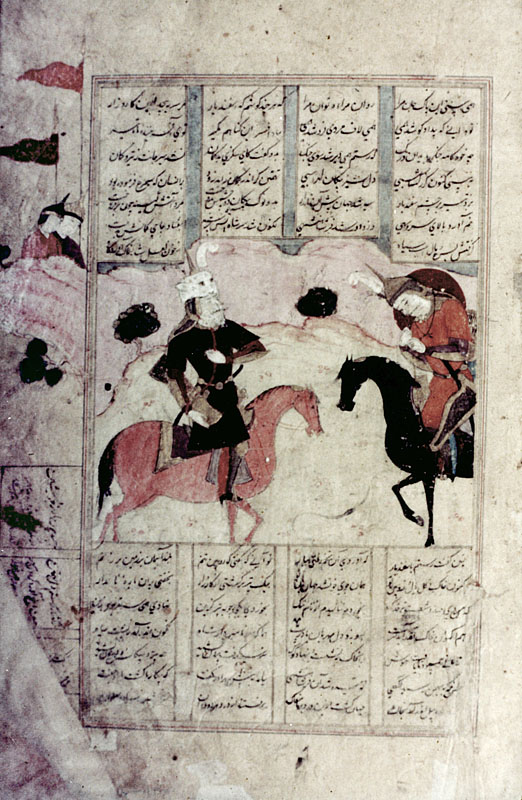Rostam Shoots Esfandiyār in the Eyes with a Double-pointed Arrow
Location: Current whereabouts unknown. Formerly in the Kraus Collection, New York.
Page: not known
Painting: not known
Text area: not known
Signature: An inscription in miniscule characters, in the center of the lower margin, isonly faintly visible in the photograph follows Moʿin’s traditional formula of humility: raqam zad kamina moʿin-e moṣavver.
Esfandiyår, portrayed in an orange tunic and pointed steel helmet on the right side of the painting, slouches slightly forward in the saddle of his black horse, clutching the shaft of a double-pointed arrow that has found its mark in both his eyes. His bow has fallen from his hands and lies on the ground at the feet of his horse. Esfandiyår’s adversary Rostam, clad in his familiar tiger skin coat and leopard skin headdress, sits astride a rust-colored Raḵš on the left side of the painting, with bow in hand. Only two other figures are represented in the scene, both warriors wearing pointed steel helmets, who peer over the ridge in the upper left where the painting extends into the margin. The setting is an off-white, non-descript hillside that rises to a ridge mid-way up the picture. Behind it is a second hill rendered in pink, and in the far background a blue sky.
There are four columns of text above and below the painting. In addition, three columns with three lines of text each are written in the lower margin outside the frame; two of these columns are written vertically. A rectangular frame encloses miniature and the four main columns of text. The painting extends into the margin on the left side where two warriors holding a standard are portrayed. The page has suffered from abrasion and flaking that has damaged the features of Rostam and the two warriors in the background, as well as in less critical areas. The lower left corner of the page is missing, the lower right corner has been torn, and the text is smeared in a number of places. The general style of the painting can be associated with Moʿin, but the poor quality of the photograph does not allow us to judge whether this is the work of the master or an assistant.
See Manuscript D, folio 44 for another version of this subject painted by Mo¯in.
Painting references:
Unpublished
Text references:
Warner,V, pp.243-44; Mohl, IV, p.545; Levy, pp.210-11.
Photo by the author
Robert Eng
Last Updated: July 13, 2015 | Originally published: July 13, 2015
